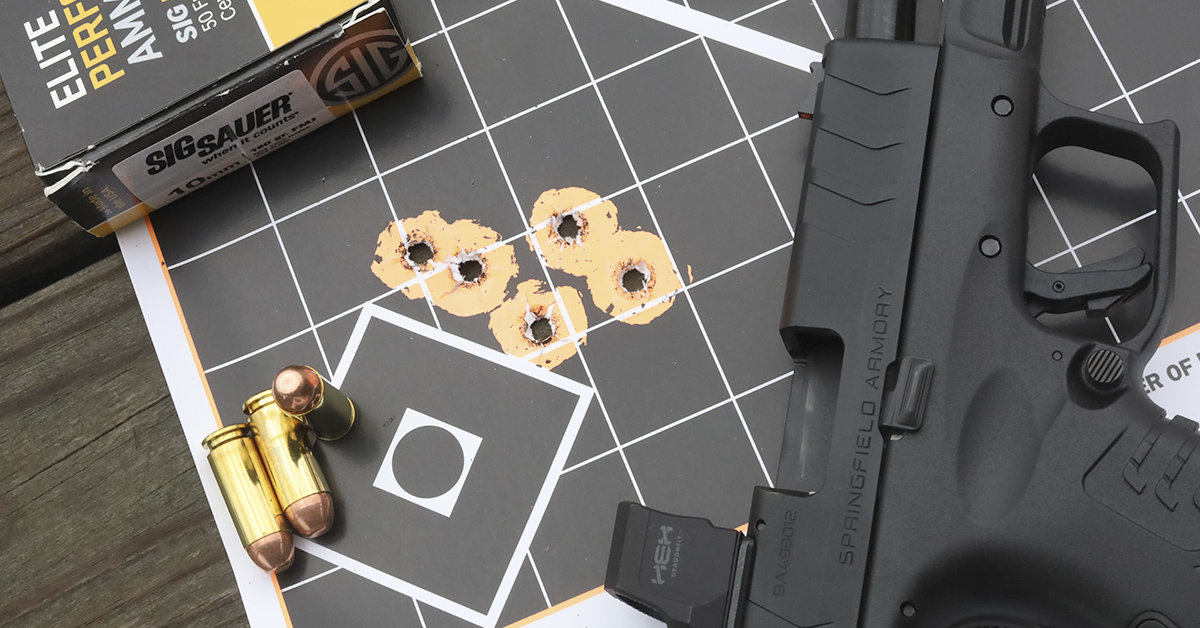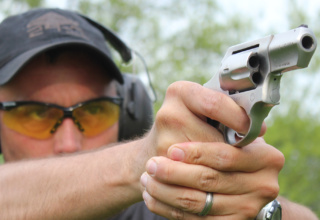The 10mm Auto cartridge has struggled to find its place, but does its newfound popularity mean it is here to stay?
by Brad Fitzpatrick
The 10mm Auto cartridge came to pass in 1983, but the cartridge was not an immediate success. This had less to do with the failings of the 10mm Auto itself and more an issue of bad timing and manufacturing failures. Among the cartridge’s early supporters was Colonel Jeff Cooper, a master of combat pistol tactics, and it was Cooper who saw the usefulness of a cartridge that could push a 200-grain bullet from the muzzle at 1,200 feet per second. When Colonel Cooper talked, shooters listened, and firearms manufacturer Dornaus & Dixon developed the first 10mm pistol in 1983.
That pistol was the Bren Ten, and it was mechanically similar to the CZ 75. The problem was that Dornaus & Dixon had manufacturing issues that resulted in limited production. Guns that were shipped often came without magazines, so it’s no surprise that the 10mm Auto got off to a sluggish start.
Things changed in April 1986 when FBI agents in Miami engaged in a shootout with two bank robbers. The bank robbers — William Matix and Michael Platt — were killed during the shootout, but two FBI agents were also killed. The FBI realized that the 9mm Luger cartridges used by agents during the shooting failed to stop the bank robbers despite accurate hits.
Almost immediately the FBI set out to select a cartridge that was more effective than the 9mm Luger, and the 10mm Auto was the natural choice. Cooper’s desired 200-grain bullets at 1,200 feet per second produced almost twice the muzzle energy as the 9mm Luger. It seemed that the 10mm Auto might be prepared for a revival.
The 10mm, though, was dealt a bad hand. The FBI decided the cartridge produced too much recoil for some agents. The .40 S&W, which is essentially a shortened 10mm Auto cartridge, was adopted by the FBI. And, once again, the 10mm faded into the shadows.
In latter years, though, the 10mm Auto grew more popular. Shooters found that the cartridge produces far more energy than the 9mm Luger, .40 S&W, and the .45 ACP. The 10mm held more rounds than .45 ACP pistols and .357 Magnum revolvers, and experienced shooters found that, despite the 10mm’s substantial recoil, guns chambered for the round were still manageable. Interestingly, improved bullets would eventually change the 9mm Luger’s fate. FBI protocol testing helped improve bullet design, and now the 9mm has replaced the .40 S&W as the most popular chambering for law enforcement agencies.
The 10mm Deserves Attention
About 10 years ago, shooters began embracing the 10mm Auto. Perhaps we finally realized what it had to offer: impressive ballistics and better capacity than the .45 ACP or any revolver. The 10mm Auto does produce substantial recoil, but in most average-weight pistols, it’s not intolerable for experienced shooters. It’s certainly better than any of the big bore revolvers, and my 40-ounce 1911 10mm isn’t uncomfortable to shoot from the bench. Is it a cartridge that makes sense for entire agencies with shooters of every skill level? No. But if you’re a shooter with good form who can handle a bit of recoil, it’s not bad. Truth be told, if I had to choose among shooting a small-frame .357 Magnum, an ultra-small 9mm, or a full-sized 10mm, I’d go for the 10 every time.
The 10mm hits hard at both ends, and that’s one reason it’s so versatile. Federal’s Punch defensive ammunition carries roughly 490 foot-pounds of energy at 50 yards, which is about 130 foot-pounds more than their 124-grain 9mm Punch load generates at the muzzle. Hornady’s 180-grain XTP 10mm load strikes with an even greater 525 foot-pounds of energy at 50 yards.
Part of the 10mm’s appeal is the added energy it offers. It’s more gun that you need for concealed carry, to be sure, and most shooters will be better served with one of the myriad of 9mm carry pistols available today; however, if you’re looking for a round for defense against four-legged predators, the 10mm is a good option. I carry a Rock Island Armory TAC Ultra FS 1911 10mm Auto when I’m in grizzly country, and that gun offers a capacity of up to nine rounds. It’s also more comfortable to carry than a heavier .44 Magnum. There’s no doubt that the 10mm Auto has become more popular among guides, hunters, backcountry hikers, and anglers who spend time in the wilderness where large bears are a constant threat. On an Alaskan hunt four years ago, every guide and hunter in camp who carried a backup gun had a 10mm, and that hints at the cartridge’s growing popularity.
The 10mm is also a suitable hunting round. It’s not a long-range hunting cartridge to be sure, but for deer and hogs at suitable distances (say 50 yards) it works fine. There are also a lot of different firearms chambered for the round, so whether you’re hunting or defending yourself from large predators, you’ll find a 10mm that suits your needs. Kimber, Rock Island, Colt, Ruger, and other brands all offer (or have recently offered) 10mm 1911 pistols, and if you’re familiar with the 1911 platform, these are obvious choices when looking for a 10 mil. The same is true if you are a fan of polymer-frame striker-fired pistols. Glock, SIG, Springfield, and other companies offer 10mm striker-fired 10mm autoloaders, so if you carry a 9mm from one of these brands, it’s a natural transition to a 10mm. These double-stack 10mms offer exceptional capacity for a bear defense gun, too. Springfield’s XD-M 4.5-inch autoloader holds 16 rounds of 10mm ammo, which provides peace of mind when you’re in bear country. There are also affordable options: Hi-Point offers their JXP10 pistol for just $225. It’s certainly a no-frills pistol that’s heavy and has some cheap bits, but I tested it with a variety of 10mm loads and the gun proved reliable with every 10mm round I fed it.
There are also revolver options. Smith & Wesson offers their Model 610 double-action revolver with two barrel lengths, and it’s a great option for anyone searching for a wheelgun. Additionally, Ruger offers the 10mm both in their GP100 line as well as their Super Redhawk series. There’s also growing interest in 10mm pistol caliber carbines (PCC) such as the Ruger LC carbine and Hi-Point’s 1095.
The 10mm offers unmatched load versatility among autoloading pistols. Rounds like Federal Punch (200-grain bullet at 1,100 fps) and Hornady Critical Duty (175-grain bullet at 1,160) are relatively mild by 10mm standards and are more suitable for home defense. At 1,200 feet per second, Federal’s 200-grain Solid Core ammunition offers more punch and a bullet that is designed for deep penetration on large predators. Hornady’s Handgun Hunter utilizes a slightly lighter (135-grain) Monoflex bullet at 1,315 fps and is designed with hunters in mind. No matter what your intended use, there’s likely a 10mm bullet for the job.
The 10mm is Not for Everyone
The 10mm is a very versatile round, but it isn’t right for everyone. If you want a concealed carry or home defense pistol, the 10mm is truly more gun than you need. Will it work? Sure, but it produces more recoil and muzzle flip compared to a full-sized or even a compact 9mm, making follow-up shots slower. Because of the recoil generated by the 10mm round, it’s also more difficult for some shooters to master. Unless you are planning to hunt or need a gun to stop an irate grizzly, there are plenty of lower-recoiling cartridge options.
As stated, there are lots of 10mm Auto ammo options, but ammunition for a 10mm consistently costs more than 9mm ammo. Whereas there are lots of 9mm practice loads available for around thirty cents a round, you’ll have to pay about double that for the cheapest 10mm target load. Depending on point of purchase, you can expect to spend upwards of twice the money with each 10mm trigger pull that you’ll spend shooting a 9mm. While most gun stores carry 9mm, .380 Auto, and .357 Magnum ammo, you’re less likely to find 10mm ammo at stores with limited ammo selection.
The 10mm has its place, and it certainly packs a punch. Do you need all that it has to offer? That’s up to you, but let’s hope that the 10mm’s newfound acceptance makes this round relevant well into the future. It took a few decades, but the 10mm has finally won enough fans that it looks like it will hang on for the foreseeable future.
- PERSONAL DEFENSE: Preparing for the Worst - December 31, 2025
- Six Great Shotguns Under $1,000 (Plus One Shotgun Everyone Should Own) - November 28, 2025
- Eight Great Revolvers for Self-Defense - September 23, 2025




















